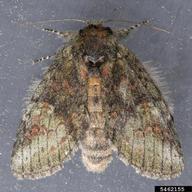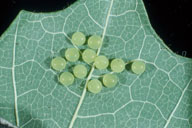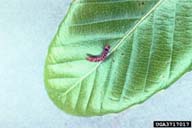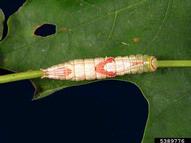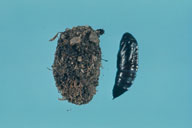Saddled prominent
Heterocampa guttivitta (Walker) Lepidoptera: Notodontidae)
Orientation to pest
Saddled prominent, Heterocampa guttivitta (Walker), is a native North American notodontid that occurs in southeastern Canada and throughout the eastern United States, feeding on beech (Fagus grandifolia Ehrh. ), paper birch (Betula papyrifera Marshall), sugar maple (Acer saccharum Marshall) and many other hardwoods. Adults fly in spring and lay up to 500 eggs singly on the host's leaves. Young larvae skeletonize leaves, while older ones consume all but the larger veins. During outbreaks, larvae may move from tree to tree. In mid-summer, larvae move into the leaf litter, where they pupate and then pass the winter. There is one generation per year in the northern part of the insect’s range. Periodic outbreaks have occurred, especially in the northeastern United States, and these may defoliate, and sometimes kill or top-kill affected trees.
Hosts commonly attacked
This caterpillar feeds most commonly on American beech (F. grandifolia), paper birch (B. papyrifera), and sugar maple (A. saccharum).
Distribution
The saddled prominent occurs in southeastern Canada and throughout the eastern United States.
Images of saddled prominent
| Figure 1. Adult of saddled prominent, Heterocampa guttivitta | Figure 2. Eggs of saddled prominent | Figure 3. Young larvae of saddle prominent have structures near head that resemble horns |
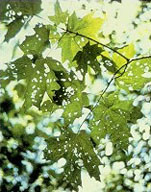 USDA Forest Service, Forest Insect & Disease Leaflet 167 USDA Forest Service, Forest Insect & Disease Leaflet 167 |
||
| Figure 4. Mature larva of saddled prominent | Figure 5. Pupal cell (left) and pupa (right, removed from cell) of saddled prominent | Figure 6. Appearance of saddle prominent feeding on maple |
Important biological control agents related to this pest species
The parasitoids recorded from various life stages of the saddled prominent include the scelionid egg parasitoid Telenomus coelodasidis Ashmead and the larval parasitoids Phobocampe pallida (Cushman) (Ichneumonidae) and Eulophus anomocerus (J.C. Crawford) (Eulophidae), both of which were uncommon (<1% parasitism). Another ichneumonid, Cratichneumon sublatus (Cresson), is the main pupal parasitoid, attacking 1-17% under outbreak conditions and 32-57% in the year following the collapse of its host's population.
Web links for information on saddled prominent
Articles
- Fisher, G. T. 1970. Parasites and predators of the species of a saddled prominent complex at Groton, Vermont. Journal of Economic Entomology 63: 1613-1614.
- Allen, D. C. 1972. Insect parasites of the saddled prominent, Heterocampa guttivitta (Lepidoptera: Notodontidae) in the northeastern United States. The Canadian Entomologist 104: 1609-1622.
- Allen, D. C. 1973. Fecundity of the saddled prominent, Heterocampa guttivitta. Annals of the Entomological Society of America 66: 1181-1183.
- Grimble, D. G. and R. G. Newell. 1973. Damage to sugar maple in New York State from saddled prominent defoliation. Applied Forestry Research Institute Note No. 7. Syracuse, NY: Syracuse University, 4 p.
- Spear-O'Mara, J. and D. C. Allen. 2007. Monitoring populations of saddled prominent (Lepidoptera: Notodontidae) with pheromone-baited traps. Journal of Economic Entomology 100: 335-342.
